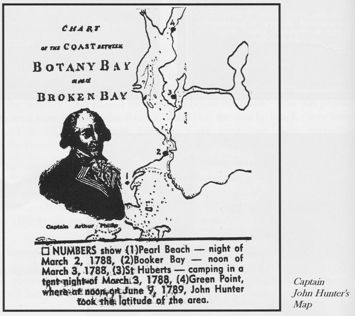Early Days
Information on Phillip's travels and available to historians, includes parts of a map of the area which was surveyed by Captain John Hunter in 1788 and 1789. This map, which was printed by Stockdale in London in 1792, shows St Huberts and Rileys islands fused together with the Saratoga Peninsular. This distortion, amongst others contained in the map, was undoubtedly due to the fact that it was described as an "eye-sketch" of the area.
The twin islands of St Huberts and Rileys were originally known as Bird and Shell respectively.
A communication provided to the author, stated they were advertised by the Government for sale during the early 1830's. They were described as being in Brisbane Water near Cockle Creek. Despite the dates of 11th May 1832 and 1834 being given as alternative dates for the advertisement, a search of the early Government Gazettes for the advertisement proved unsuccessful.

It seems that no interest could have been shown in them at the time, as the first record of the sale of larger island (Bird) was to a Father Coghlan, who apparently took advantage of the "New Land Regulations" which declared "... country and special country lots put up for sale and not bid for, may be claimed without compensation ...". His purchase was entered in the Register of Land Purchases on 15th October 1856 some nine years after he had left the district. The ‘mechanics' of his purchase is not known, and it may be that the payment was made over a period of time and his ownership not recognised until payment in full had been made.
It is recorded that the priest paid 154 pounds and ten shillings for his purchase. This being a very considerable sum of money for those days, it seems highly likely the purchase was not made in one payment.
Interestingly, when Father Coghlan died, his will showed him as distributing 1,000.00 pounds sterling to recipients. It would seem Father Coghlan must either have been the recipient of an inheritance or had other sources of income.
Some light may have been shed on this aspect of Father Coghlan's activities, as evidenced in a letter written to Mrs J Sharpe (nee Kerrie Powell, the daughter of Thomas Powell, one of the Island's early owners) to her Aunt Noreen Roach.
In a brief historical overview, Kerrie Powell wrote:
"... On the western side of Rileys (Island) where the channel dividing the two islands ends, there was a large pine tree, near which the priest had built an illegal still for the distilling of whisky. The foundations to the supposed still were still visible to us during the early sixties ...".
Such comment may be no more than the propagation of a rumour, since the Rileys carried on boat building activities on their island, and items used in this activity could easily have been mistaken for the said still.
